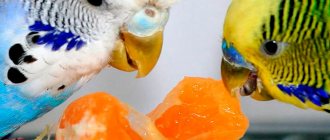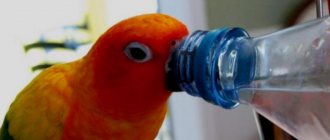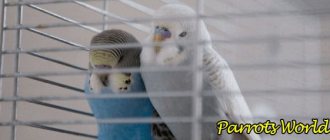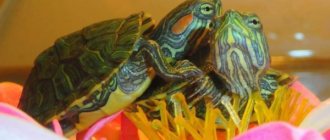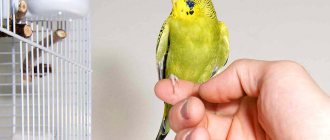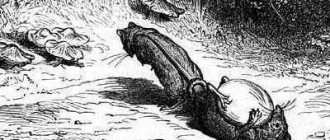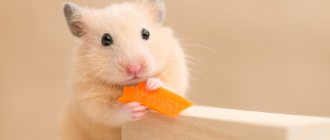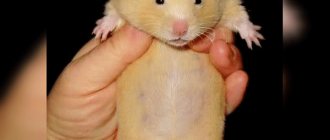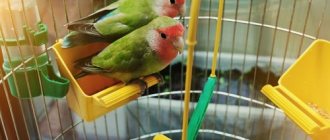Online magazine about parrots
Colors and patterns of budgies
We have translated and compiled for you a guide to the colors and patterns of budgerigars
Look
Popular article
Let's figure out how to choose a mate for a male or female budgie
2
Home › Reproduction
Breeding budgies is considered not too difficult, but a troublesome task. The owner must first perform some steps to allow the birds to prepare for nesting.
To do this, a pair of wavy birds is wisely selected, a large cage is purchased, and a nest or house is made. It is advisable to monitor each stage of bird breeding, as this process is amazing and interesting.
In the article we will discuss the topic of how long budgies hatch eggs and all the subtleties associated with the process.
- How many days does incubation take?
- When do birds start laying their first eggs?
- How birds fly
- What problems arise
- How many days do chicks hatch?
- Useful video
- Conclusion
How many days does incubation take?
Female wavy birds can lay eggs alone, but such eggs do not hatch into chicks. Therefore, if you want to breed, then fertilization is required.
To do this, a pair is carefully selected, and a young female must be chosen for the male, who will not behave aggressively or dominate.
As soon as sympathy appears between two parrots, they will begin to sing, dance and even sleep together. Mating is the culmination of the courtship period. The process is performed for about a week, several times a day. Sometimes fertilization occurs the first time.
The first egg appears approximately 10 days after the birds mate. During this period, the female stops responding to the male, and also tries to spend a lot of time alone, choosing a nest or house for this.
The process of laying eggs is considered exhausting and difficult, so during this period the female behaves tensely and also breathes heavily. It is advisable not to approach the cage at this time so that the bird does not leave the nest. A parrot can lay one egg about once a day. In total, the female lays from 3 to 8 eggs.
If the female has more than 8 eggs, this can lead to difficulties during incubation, since the testicles will not be able to fit under the bird.
The female immediately begins to warm the eggs, a process that takes approximately 22 days to complete. After this, the chicks are born. Hatching time depends on the number of eggs and the age of the parents. The process occurs quickly in summer and in young parrots.
It is also useful to read: Does a budgie need a mate?
Bird mating games
Parrots, like any other bird, have a mating season. How do you know if birds are ready to become parents?
The male begins to court the female. He curls around her, chirps affectionately, tries to kiss her. Budgerigars kiss, their beaks touching.
If the female is ready for courtship, she favorably accepts it. He rubs his head against the “groom’s” neck. Like a decent lady, she allows herself to be kissed. Seeing all this, the owner understands: the time has come to prepare the nesting house.
How long do budgies hatch eggs? Be patient, this is discussed a little below.
When do birds start laying their first eggs?
If a beginner decides to start breeding wavy fish, then he must be patient with this process, which is divided into several stages:
Initially, you need to choose the right pair so that a trusting and warm relationship is formed between the birds;- the courtship period can even last several months;
- if the female allows the male, then from the moment of mating until the appearance of the first egg, approximately 10 days pass;
- the owner can easily understand when the egg-laying process begins, since the female begins to push away the male, often retreats into the house, and her tail periodically shakes and her breathing becomes heavier;
- before laying itself, the bird plucks its feathers;
- eggs appear daily or every other day, and in young females their number is much greater than in mature birds.
The female does not always begin to warm the eggs immediately, so the incubation process may begin after a few days.
House installation
2 weeks after the preparation stage, a house must be installed in the cage. The optimal size of the house is 20 x 20 x 15 cm.
Don't worry if the female doesn't react and doesn't go there. In a couple of days she will get used to it, begin to become interested and build a nest there.
For this she will need building material. Sawdust, dry grass and thin twigs are placed in the cage. As a preventive measure against parasites, you can add dry medicinal chamomile.
The female will independently carry the material into the house and arrange the nest; she should not be helped.
How birds fly
During this period, each bird has its own responsibilities, so the following features are taken into account:
- the female incubates the eggs almost all the time;
- the male takes care of the girl, so he brings her food and also periodically cleans her feathers;
- sometimes males are constantly near the entrance to the house or nest, talking and singing;
- the female leaves the house to go to the toilet, and at this time a person can clean the nest or add some sawdust, but sometimes the female reacts too aggressively to interference;
- It is forbidden to touch the eggs with bare hands, so you need to wear gloves, otherwise the female may abandon the nesting site;
- periodically the female turns the eggs over for uniform heating;
- after 10 days, you can carefully take the testicle and hold it up to the light to determine whether it is fertilized;
- if a dark spot and a network of vessels are visible, then small chicks can be expected soon;
- if the egg is completely light, then it is represented by a pacifier, but it is advisable to leave it for another 11 days;
- Experienced owners even sometimes clean eggs from bird droppings or seal cracks with adhesive tape, but without experience it is not advisable to perform these actions, as this can lead to damage to the egg.
Did your parrots have chicks?
Not really
The bird incubates the eggs for 20 to 25 days, and
the female maintains an optimal temperature for the embryos, which is approximately 37 degrees .
Sometimes the bird wets the eggs with water from the drinking bowl. She turns them over periodically to ensure even heating, so doing this yourself is not recommended. As soon as the embryos gain enough strength, the process of pecking the shell begins.
In the photo you can see what a fertilized egg looks like:
Difficulties of home breeding
Most novice breeders are faced with the fact that their pair does not reproduce, although all conditions for their nesting have been created. And the house hangs, and the food is good, and the daylight hours are correct. But the couple still does not begin to mate, despite all the mutual understanding and positive communication. Why is this happening?
The fact is that parrots are flocking birds, and the process of their reproduction is much easier when they are kept in a flock. For this you need an aviary or a large cage. And the more pairs there are in it, the greater the chance that they will reproduce.
In flocks of more than 20 individuals, the chances of the emergence of pairs in general and clutches of certain pairs are much higher. This is due to the hormonal background that is formed in birds, observing this process. Flocks of smaller sizes reproduce more slowly, and one pair of wavy birds will work on the future young even less willingly.
Sometimes it is quite problematic for novice breeders to breed these ornamental birds for one more reason: they put them in a rather modest-sized cage.
The fact is that females are unlikely to lay eggs in a small space. It just so happens that people sometimes raise two children in a one-room apartment, but parrots do not want to breed in a small cage.
The cage size for a pair of parrots should correspond to the following dimensions:
- length – 60 cm;
- width and height 40 cm.
In addition to the cage, you will need a nesting house. You can make it yourself with your own hands, but you don’t need to hang it right away. The couple must go through all the stages of the relationship and only then, when you see that the birds are mating, you need to install it in the cage.
What problems arise
The owner must monitor the process of hatching eggs in order to promptly identify any difficulties. With some effort, such problems can be eliminated.
The most common force majeure events include:
- Both parrots are flying . This indicates that the cage contains two females who have reached sexual maturity, but are carrying unfertilized eggs. This is usually associated with a high-calorie diet, so it is necessary to cut back on the diet. Hormonal imbalances may occur, so it is recommended to reduce the amount of fatty foods. If a person is aimed at breeding birds, then he will have to look for a mate for each female.
- The bird pecks the eggs. Often, young females, after laying an egg, immediately begin to peck it. This is usually caused by not having enough calcium, so you need to hang a mineral stone. Other reasons include stress or lack of experience on the part of the wavy. Sometimes birds simply get tired of frequent nesting. Therefore, even during the mating period, it is necessary to establish the nutrition of the wavy animals, and also offer them a sufficient amount of vitamins and mineral stones. If this does not help, then it is advisable to remove the nesting area for a while so that the female can rest. Even the male can peck the eggs, so he needs to be transplanted into a separate cage.
- The chicks die. Sometimes only hatched chicks die, but there is no need to worry right away, since if 1 out of 5 or 6 dies, then this is considered normal. The female cannot warm up all the testicles evenly, so sometimes weak chicks hatch and quickly die. Even birds have genetic problems and developmental defects. Experienced poultry farmers note that there is incompatibility between parrots, so the pair has to be separated. Sometimes chicks die because the female flies out of the nest for a long time during the brooding period, which leads to slow development of the embryos.
To obtain strong and healthy offspring, the female must eat well during the mating and brooding period.
Reasons why the clutch turned out without fertilized eggs or with frozen
When there are one or two frozen eggs in the clutch, there is no need to worry. Even due to inexperience, the female may not have warmed all the eggs evenly. If all the offspring died, it is worth thinking about the reasons.
These could be infectious diseases of parrots, improperly formulated bird nutrition, poor-quality water, genetic incompatibility of parents, inappropriate humidity in the apartment, or the female is not able to hatch eggs normally.
As for unfertilized eggs, the most common reason is that the birds were not properly prepared by the breeder. But it happens that the reason lies in health problems in one or both parrots. Even the wrong location and quality of the perches can affect the result.
How many days do chicks hatch?
Usually the first chicks hatch literally 18 days after the start of egg laying. They are born one after another , and a person can periodically look into the nest to catch an amazing moment.
Sometimes the female refuses the chicks, so she does not feed them or kills them altogether. The chicks are blind and also lack feathers.
They cannot feed on their own, and their weight does not exceed 2 grams. They don't roll over or move.
The female feeds the chicks with goiter milk.
The exact time of birth of the chicks depends on the number of eggs, as well as on the time spent by the female on oviposition. Sometimes the last egg lies for up to 28 days, but usually a very weak bird appears.
If there are eggs left after 4 weeks, they should be thrown away. The wavy birds feed their offspring for about 2 months, after which the chicks begin to fly out of the nest. It is at this time that they need to be placed in a separate cage, and also distributed to new owners.
The female needs to rest before the next mating, so it is necessary to remove the nesting area, and it is also advisable to separate the pair for a while.
Conditions of detention
Comfortable conditions for mating are one of the key points when breeding budgerigars at home.
- The first step is to disinfect the cage and accessories.
- Then the daylight hours are increased to 14-16 hours. This must be done gradually, otherwise you can provoke molting.
- The cage should be in a quiet and peaceful place, where there is no noise or extraneous sounds.
- The air temperature should be around 20-23 degrees, air humidity about 60%.
